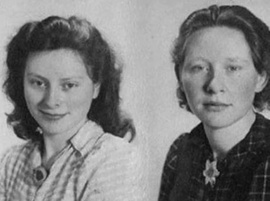How extraordinary! They were only 14 and 16.
The Teenage Girl Gang That Seduced and Killed Nazis
Freddie and Truus were, for a time, the only two women in the seven-person rebellion dubbed the Haarlem Council of Resistance. After being recruited by commander Frans van der Wiel in 1941, the two learned the basics of sabotage, picking up tricks like how to rig railways and bridges with dynamite so travel paths would be cut off; how to fire a weapon; and how to roam undetected through an area peppered with Nazi soldiers. The latter ability was a result of their appearance. With her hair in braids, Freddie was said to have looked as young as 12 years old. Few soldiers took notice of the two girls as they rode bicycles through occupied territory, though they were secretly acting as couriers, transporting paperwork and weapons for the resistance. The duo burned down a Nazi warehouse undetected. They escorted small children and refugees to hiding spots and secured false identification for them, which they considered of paramount importance even as Allied bombs went off overhead.
But the resistance had one other job for them, one Freddie later described as a “necessary evil.” They were tasked with murdering Nazi officers and their Dutch collaborators because no one would likely see them coming.
Some of Freddie and Truus’s assignments involved acting as bait. Once, while Freddie stood as a lookout, Truus entered a restaurant and struck up a conversation with a high-ranking SS officer. While flirting with him, she asked him to go for a walk in the woods. Once they were isolated, Truus and her companion bumped into a man along the same path. Unknown to the Nazi officer, the man was a resistance member. He proceeded to execute the officer and leave him in a hole that had been dug earlier.
Freddie and Truus soon graduated to eliminating their own targets, which Freddie would later describe as “liquidations.” Sometimes the girls would ride a bicycle, Truus pedaling while Freddie shot from the back. They also followed the officers home to ambush them while their guard was down. While they considered the work necessary, it was difficult for the girls to accept. Sometimes, Freddie said, she would shoot a man and then feel a strange compulsion to try to help him up.
Read on: [mentalfloss.com]


Enjoy being online again!
Welcome to the community of good people who base their values on evidence and appreciate civil discourse - the social network you will enjoy.Create your free account
5 comments
Feel free to reply to any comment by clicking the "Reply" button.Amazing what people are capable of when circumstances make extraordinary demands. Necessity is the mother of.... liquidation.
The article continues as follows:
Ryo1:
The only mission they refused to act in was a plot to kidnap the children of senior Nazi officer Arthur Seyss-Inquart, the idea being that his kids could then be exchanged for imprisoned Dutch radicals. Fearing the kids might be harmed in the process, Freddie and Truus declined.
The girls were joined by a 22-year-old former law student named Jannetje Johanna "Hannie" Schaft in 1943. The three women became inseparable, acting as a tightly coordinated unit for sabotage missions. For the next two years, they continued to target officers and elude identification, though the Nazis knew Schaft by her distinctive red hair.
It was this colorful feature that would be the trio's undoing. In April 1945, just weeks before the end of the war, Freddie and Truus grew worried when Schaft failed to report back after an assignment. They were horrified to discover their friend had been grabbed at a checkpoint when an officer recognized the red roots of her hair, which she had dyed black to avoid detection. Schaft was executed on April 17, and lore has it she taunted her executioner after he failed to kill her on his first attempt. “I’m a better shot,” she reportedly said.
Grieving over the loss of Schaft, Freddie and Truus tried to enter civilian life following the war. Freddie got married and had children, which she later said was her way of dealing with the trauma. Truus poured her emotions into artwork, sculpting memorials to Schaft, and wrote a memoir. The sisters later opened the National Hannie Schaft Foundation in 1996. In 2014, Prime Minister Mark Rutte awarded the Mobilization War Cross for their service during the war, recognition that had been a long time in coming. (For years, Freddie felt overlooked because she once belonged to a Communist youth group and believed the anti-Soviet Dutch government held it against her.) Truus died at age 92 in 2016. Freddie followed in 2018.
It’s not known exactly how many Nazis the girls killed, as both were reluctant to discuss it later in life. When asked, Freddie would respond with, “One should not ask a soldier any of that."
Hardcore, I wonder how they turned out, they are at an impressionable age for ptsd.
Wikipedia for Freddie from a Google search. I don't personally know much about them.
[en.m.wikipedia.org]
Apparently they were sisters and Freddie died of a heart attack the day before her 93rd birthday -- as a mother of 3.
Enjoy being online again!
Welcome to the community of good people who base their values on evidence and appreciate civil discourse - the social network you will enjoy.Create your free account
Share this post
Categories
Agnostic does not evaluate or guarantee the accuracy of any content. Read full disclaimer.







